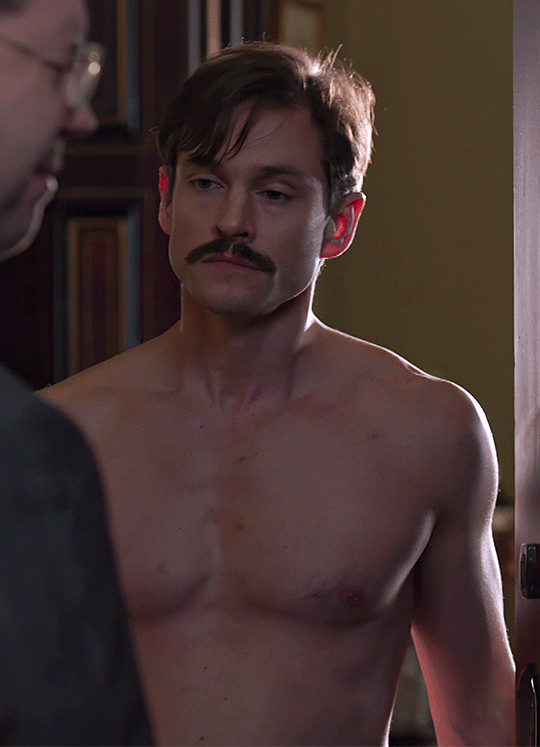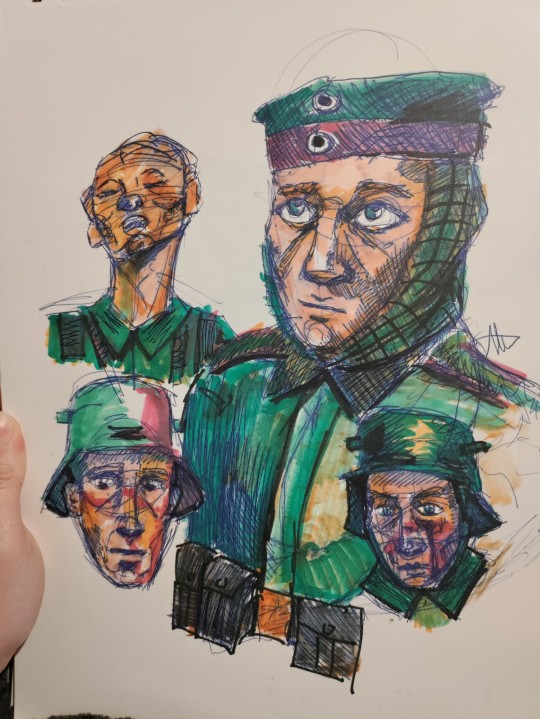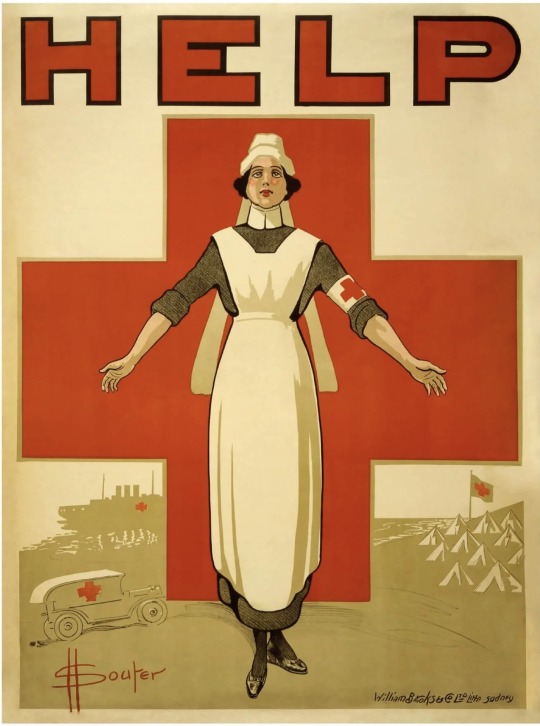#wwi history
Explore tagged Tumblr posts
Text
One of the things I love so much about Dead Boy Detectives is how much attention is paid to detail, even on little things, even when they didn't need to go that hard.
Take the very first case. This WWI ghost?

Was killed by chemical warfare.
If you've done any reading on WWI, one of things that comes up again and again was that it was the first major conflict where chemical warfare and gas attacks were employed against soldiers on the ground.
Soldiers on both sides were terrified by it. They had gas masks with them all the time, when there were enough to go around, but sometimes the gas masks failed.
And if someone was hit by a gas attack, what were some of the symptoms? Blistered skin, blisters in the lungs, and irritated eyes, up to and including blindness.
This man was killed by a gas attack, probably mustard gas, and likely when his gas mask failed.
They never mention it in the dialogue. Maybe Edwin and Charles don't even know.
But the show runners did the research and designed his makeup accordingly and slipped in that little nod for anyone who knows the history.
God damn. This series was made with so much care, and it shows.
#dead boy detectives#dbda#wwi#wwi history#makeup#sfx#sfx makeup#halloween#spooky season#netflix#meta commentary
2K notes
·
View notes
Text

WWI, 1 May 1918; A Machine Gun Corps post in a barn near Haverskerque, The Battle of the Lys (Operation Georgette).
#wwi#ww1#the great war#british army#british soldiers#war history#photography#tumbler#1910s#first world war#world war 1#world war one#world war i#heavy machine gun#machine gun#great war#tumblr#soldiers#wars history#wwi era#ww1 history#wwi history#circa 1918#1918#history
212 notes
·
View notes
Text

Erich Maria Remarque you have ruined me
#i’m on a work trip rn for one of my jobs so i can’t post a ton of art but i AM reading this book for the 20th time#i need to find every person who’s ever read this book and sit them down. and look at them. that’s all#page 94-97. oh man. oh boy!#giggle. i’m so normal#all quiet on the western front#erich maria remarque#paul baumer#stanislaus katczinsky#those yellow boots are haunting the narrative#you ever look at your comrade roasting a goose and think yes i am experiencing the horrors but his shadow is home#and he holds the world on his shoulders#he is my comrade and he is mt brother and he is and he is and he is#wwi#wwi history#wwi literature
213 notes
·
View notes
Text

Crew conducting drills aboard USS TEXAS (BB-35), likely in Firth of Forth, Scotland.
Photographed in early 1918.
source
#USS TEXAS (BB-35)#USS TEXAS#New York Class#battleship TEXAS#Dreadnought#Battleship#Warship#Ship#United States Navy#U.S. Navy#US Navy#USN#Navy#World War I#World War 1#WWII#WW1#WWI History#History#Military History#Firth of Forth#Scotland#undated#1918#February#my post
159 notes
·
View notes
Text


HUGH DANCY as Ellis Ashmead-Bartlett 2015 · Deadline Gallipoli · S1·EP1 · dir. Michael Rymer
#hugh dancy#deadline gallipoli#perioddramaedit#tvedit#ellis ashmead bartlett#actor#ellis ashmead#men#periodedit#perioddramagif#perioddramasource#world war 1#wwi history#wwi#beautiful men
366 notes
·
View notes
Text

British troops returning from leave, Mailly Maillet, Somme.
November 1916.
The group of soldiers includes men of the Lancashire Fusiliers, York and Lancaster Regiment, and the Duke of Wellington's Regiment (West Riding).
Image: IWM (Q 1601)
Colourised by Doug
28 notes
·
View notes
Text

Naval Air Factory N-1 floatplane (A2282) conducting a test run from the Philadelphia Naval Aircraft Factory.
Date: May 24, 1918
source
#Naval Air Factory N-1#NAF N-1#N-1#Floatplane#Philadelphia Naval Aircraft Factory#Philadelphia#Pennsylvania#May#1918#United States Navy#U.S. Navy#US Navy#USN#Navy#World War I#World War 1#WWII#WW1#WWI History#History#my post
201 notes
·
View notes
Text
Yet another one of my book reviews.

This is fantastic. However, it's not for most people. The book reads similar to a dissertation or more like a dissertation that has been rewritten for publication.
It covers the time between the end of WWI and the end of WWII.
Very statistical minded, it is fascinating. One of the early topics in the book is the percentages of Protestant suicides and Catholic suicides, for example.
It also takes into consideration how small villages it was easier to cover up such things. Statistically speaking, there is room for error at +/- percentages m.
Again, it isn't for everyone. Despite the topic being so very harsh, I enjoyed the book greatly.
It's a dry read, as with most dissertation style books/writing. I'm into that, however.
If you are interested in statistics and psychology, along with the wars, you might find it interesting.
13 notes
·
View notes
Text


🥀🦌 St. George or the Dragon Slain 🏹🐉
#Happy birthday 🥳 babygirl etc#archduke franz ferdinand#franz ferdinand#history art#my art#historical fanart#19th century#20th century#wwi history#Patron saint of unapologetic obsession rage and love... patron saint of bad luck patron saint of black sheep#Patron saint of doomed by the narrative</3
11 notes
·
View notes
Text

"Died for France on 29 April, 1916." Monastery de Cimiez Cemetery, in Nice, France.
#cemetery#wwi#wwi history#france#nice#tomb#original photography#photography#taphophile#taphophilia#lensblr#photographers on tumblr#tombs#history#wanderingjana
30 notes
·
View notes
Text

Two German Soldiers NCOs tooled up and ready to go, probably on a trench raid against the French or British, Western Front, c.1916.
#wwi#ww1#western front#wwi era#germany#ww1 era#trench#in the trenches#first world war#world war 1#world war one#world war i#wwi history#ww1 history#war history#1910s#1916#war#tumbler#photography#world war#military history#gas mask#german history#history
247 notes
·
View notes
Text

All Quiet on the Western Front doodles
#netflix#selftaughtartist#fanart#all quiet on the western front#wwi history#the great war#world war one
18 notes
·
View notes
Text

HMS AGINCOURT underway.
Photographed in 1916
source
#HMS AGINCOURT#Battleship#Dreadnought#Warship#Ship#British Royal Navy#Royal Navy#World War I#World War 1#WWI#WW1#WWI History#History#Military History#undated#1916#my post
40 notes
·
View notes
Text

Between the Tidal Basin and the Lincoln Memorial is the D.C. War Memorial. It was built in 1931, a few years before WWII, and dedicated to soldiers from D.C. that were lost in WWI.
Explore:
#washington dc#dc#memorial#national mall#national park#wwi history#original photography#photographers on tumblr#photography#travel#urbanexploration#wandering#architecture#war memorial#national park service#historical architecture#wanderingjana
14 notes
·
View notes
Text

David Henry Souter
Australian Red Cross Poster: Help
ca. 1914-1918
Printed by William Brooks & Co. Ltd, Sydney
#dh souter#red cross#vintage posters#Australian Red Cross#australian#Red Cross nurse#nurse#nurses#nursing#wwi#wwi history#history#australian history#modern art#art history#aesthetictumblr#tumblraesthetic#tumblrpic#tumblrpictures#tumblr art#aesthetic#beauty#tumblrstyle
13 notes
·
View notes
Text
"[...] November 11, 1918.
All across the Western front, the clocks that were lucky enough to escape the four years of shelling chimed the eleventh hour. And with that the First World War came to an end.
From 10 o’clock to 11 — the hour for the cessation of hostilities — the opposed batteries simply raised hell. Not even the artillery prelude to our advance into the Argonne had anything on it. To attempt an advance was out of the question. It was not a barrage. It was a deluge. [. . .] Nothing quite so electrical in effect as the sudden stop that came at 11 A. M. has ever occurred to me. It was 10:60 precisely and — the roar stopped like a motor car hitting a wall. The resulting quiet was uncanny in comparison. From somewhere far below ground, Germans began to appear. They clambered to the parapets and began to shout wildly. They threw their rifles, hats, bandoleers, bayonets and trench knives toward us. They began to sing. —Lieutenant Walter A. Davenport, 101st Infantry Regiment, US Army
And just like that, it was over. Four years of the bloodiest carnage the world had ever seen came to a stop as sudden and bewildering as its start. And the world vowed “Never again.”
Each year, we lay the wreath. We hear “The Last Post.” We mouth the words “never again” like an incantation. But what does it mean? To answer this question, we have to understand what WWI was.
WWI was an explosion, a breaking point in history. In the smoldering shell hole of that great cataclysm lay the industrial-era optimism of never-ending progress. Old verities about the glory of war lay strewn around the battlefields of that “Great War” like a fallen soldier left to die in No Man’s Land, and along with it lay all the broken dreams of a world order that had been blown apart. Whether we know it or not, we here in the 21st century are still living in the crater of that explosion, the victims of a First World War that we are only now beginning to understand.
What was World War One about? How did it start? Who won? And what did they win? Now, 100 years after those final shots rang out, these questions still puzzle historians and laymen alike. But as we shall see, this confusion is not a happenstance of history but the wool that has been pulled over our eyes to stop us from seeing what WWI really was. [...]"
#world war 1#wwi history#james corbett#cecil rhodes#William T. Stead#reginald brett#alfred milner#lord esher#sir edward grey#lord nathan rothschild#king george v#lusitania#edward mandell house#the round table#pilgrim society#woodrow wilson#j.p. morgan#federal reserve act#smedley butler#new world order#gerry docherty#peter hof#ralph raico
3 notes
·
View notes